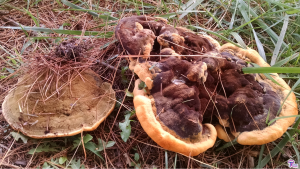#194: Spathulariopsis velutipes
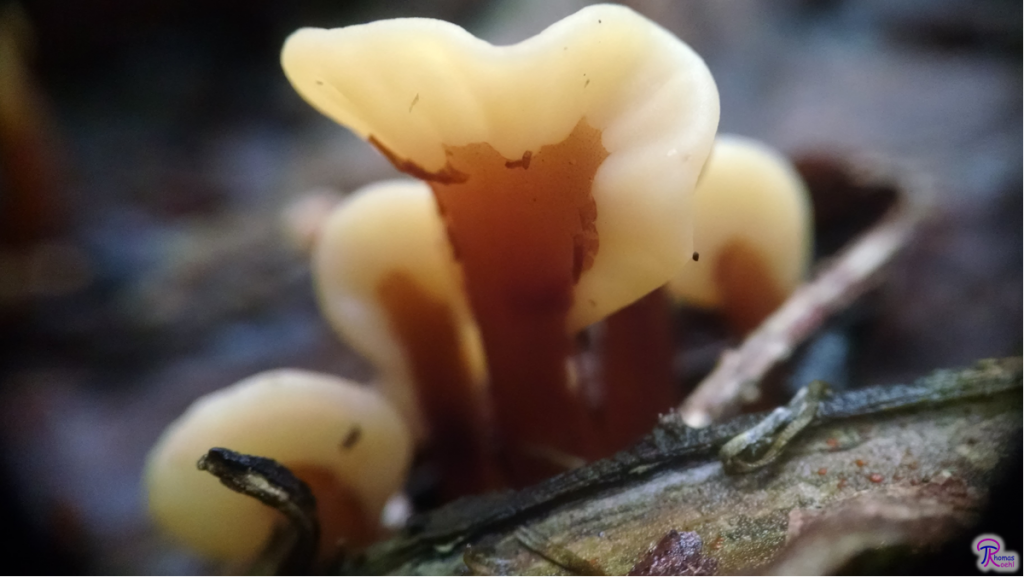
Spathulariopsis velutipes is a distinctive mushroom that looks like a malformed spatula, canoe paddle, or hand fan.
Spathulariopsis velutipes is an odd little mushroom that looks like a spatula or a canoe paddle, though perhaps in a half-melted kind of way. Its common names include “velvety fairy fan,” “velvet foot Spathularia,” and variations on those. This ascomycete is an earth tongue look-alike (ETLA)* that is easily differentiated from similar mushrooms thanks to its unique shape and the strikingly different colors and textures of its head and stipe. I always enjoy finding this mushroom because of its unique appearance.
Description
S. velutipes is considered an earth tongue look-alike, meaning it is roughly club-shaped and has two distinct parts: a sterile stipe and a spore-producing head. In S. velutipes, the head is more or less formed in a single plane and wraps around the top half of the stipe. This arrangement resembles a spatula, a canoe paddle, or a hand fan (imagine one of those cheap ones made of paper and a tongue depressor that gets distributed free at outdoor events). Whoever came up with the “velvety fairy fan” name apparently imagined fairies using S. velutipes mushrooms as little fans to cool off on hot summer days.1–3
Unlike in many ETLAs, the head and stipe are easily distinguished from one another. The head is smooth and yellowish to tan to creamy. It often becomes irregularly lobed and wrinkled, but it remains smooth aside from the wrinkles. The stipe is velvety and strikingly darker than the head, ranging from brown to reddish. Usually, the stipe is single and extends straight into the center of the head. However, it often branches and either supports a second head or grows into one of the head’s lobes. Where the stipe enters the ground, it is covered in a thick layer of orange mycelium, which attaches the mushroom to the fungus’ thallus. S. velutipes can grow up to 7cm tall and 5cm across, but it is usually much smaller; the mushrooms rarely grow larger than 1-4cm tall and 1-3cm across.1–3
When they mushroom is very young, the head is covered by a veil1,3 with the same color and texture as the stipe. In older specimens, the remnants of this veil sometimes persist as small rolls of tissue irregularly distributed along the border between the head and stipe.
Ecology
S. velutipes decomposes conifer wood as well as other debris from conifer trees. Consequently, the mushrooms appear on the forest floor and on logs; this is unusual for mushrooms, which usually stick to one or the other. The mushrooms can grow in clusters, but they more often grow scattered over a wide area. S. velutipes fruits from mid-summer through early fall.1–3
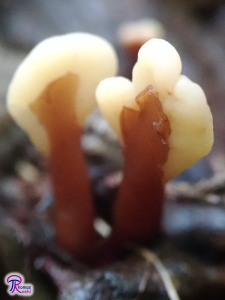
The young S. velutipes on the right has just emerged from its veil. You can see the veil material beginning to curl up at the top of the stipe.
Similar Species
There are not very many species with which you could confuse S. velutipes. Its closest look-alike is Spathularia flavida, which has a smooth, yellowish stipe and has yellow to white mycelium at the base of its stipe.4 A number of other ETLAs fit the general description, but S. velutipes and Spathularia fllavida are the only two that are spatula-like.
Edibility
Unfortunately, these visually interesting fungi do not have any uses. The mushrooms are too small and insubstantial to be considered edible.2,3
Taxonomy
Traditionally, there are three main lineages of mushroom-forming ascomycetes: the Pezizomycetes, Leotiomycetes, and Sordariomycetes. Most Pezizomycetes form mushrooms on the cup – elfin saddle – morel morphological spectrum. Leotiomycetes tend to form cups (which are often small and flat), earth tongues, or earth tongue look-alikes. In the latter two cases, most of the mushrooms have a distinct head and stipe. The Sordariomycetes include mostly ETLAs with a head and stipe that blend together, but the group also includes a few oddballs.5
S. velutipes belongs to the Leotiomycetes; it has a distinct head and stipe, which distinguishes it from other lineages. Its closest relatives are other ETLAs and some elfin saddles (yes, most elfin saddles are in the Pezizomycetes, but there are some here too).5 Spathulariopsis velutipes used to be in the genus Spathularia alongside the similar Spathularia flavida. However, Spathularia flavida lacks a veil when young; this difference was significant enough for taxonomists to move Spathulariopsis velutipes into a separate genus.1,3
| Kingdom | Fungi |
| Division (Phylum) | Ascomycota |
| Subdivision (Subclass) | Pezizomycotina |
| Class | Leotiomycetes |
| Subclass | Leotiomycetidae |
| Order | Rhytismatales |
| Family | Cudoniaceae |
| Genus | Spathulariopsis |
| Species | Spathulariopsis velutipes (Cooke & Farl. ex Cooke) Maas Geest.6 |
Note on Earth Tongue Look-Alikes (ETLAs): These mushrooms are morphologically bothersome for me. They do not have a central depression and so cannot be considered earth tongues. Most people classify them as clubs, but that poses other problems. Certain basidiomycete mushrooms are also club-shaped but produce spores all over their surface. Additionally, the entire division Basidiomycota can be called ‘club fungi’ because of the shape of the spore-bearing cells. To reduce confusion, I prefer not to call club-shaped ascomycetes club fungi. I have yet to come up with a really good descriptor for these mushrooms (my best idea so far is ‘lollipop fungi’), so for the moment I am using the term Earth Tongue Look-Alikes.
Citations
- Kuo, M. Spathulariopsis velutipes. MushroomExpert.Com (2005). Available at: http://www.mushroomexpert.com/spathulariopsis_velutipes.html. (Accessed: 4th August 2017)
- Emberger, G. Spathulariopsis velutipes. Fungi on Wood (2008). Available at: https://www.messiah.edu/Oakes/fungi_on_wood/club%20and%20coral/species%20pages/Spathulariopsis%20velutipes.htm. (Accessed: 4th August 2017)
- Labbé, R. Spathularia velutipes / Spatulaire à pied velouté. Champignons du Québec (2014). Available at: http://www.mycoquebec.org. (Accessed: 4th August 2017)
- Kuo, M. Spathularia flavida. MushroomExpert.Com (2005). Available at: http://www.mushroomexpert.com/spathularia_flavida.html. (Accessed: 4th August 2017)
- Kuo, M. Mushroom Taxonomy: The Big Picture. MushroomExpert.Com (2014). Available at: http://www.mushroomexpert.com/taxonomy.html#cudoniaceae. (Accessed: 4th August 2017)
- Index Fungorum – Names Record 323658. Index Fungorum Available at: http://www.indexfungorum.org/names/NamesRecord.asp?RecordID=323658. (Accessed: 4th August 2017)

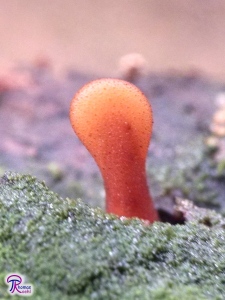

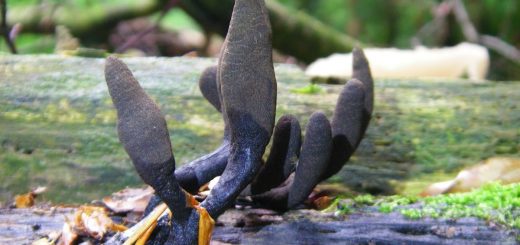
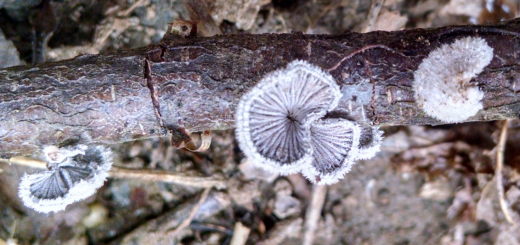





![#011: Characteristics of Kingdom Fungi [Archived]](https://www.fungusfactfriday.com/wp-content/themes/hueman/assets/front/img/thumb-small-empty.png)

